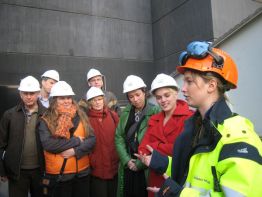Project Aim
The main aim of the project was to investigate how regions can stimulate their economies by promoting sustainable energy.
Project implementation and results
Spatial development
In the ERE project, five regions (the core partners) systematically analysed their regional situation, looking for strong points and opportunities, and assessed various ways to stimulate the regional economy through sustainable energy.
The main result of this was a toolkit, which can be found on the ERE website, containing many examples of methods and approaches, either used or only invented, for stimulating regional economy and sustainable energy.
Activities
The project demonstrated how tools, instruments and inspiring examples of how regions could energize their economies by stimulating sustainable energy made accessible for other regions. The toolkit was actually the sum of the ERE results, containing many examples of methods and approaches for stimulating regional economy and sustainable energy.
The examples were clustered around five themes: - Improve competitiveness of SMEs by improved energy efficiency;
- Stimulate innovation in sustainable energy;
- Opportunities in decentralised production;
- Finance mechanisms to stimulate promising initiatives;
- Regional interdependency.
Pilot projects
The examples of successful regions and the theoretical background on the relation between energy and economy showed that regional authorities indeed have the opportunities to use their regional qualities, which distinguish the region from other regions, to stimulate their regional economies. The five regional cases and the toolkit delivered a lot of practical examples of how this can be done. In particular, the energy inventories provided a tool to analyse a regional energy system, with the goal to better understand the effects of interventions in the system and to enable comparative analysis between regions.
Furthermore, the project provided an Internet GIS as a tool to display and find interesting initiatives and energy players. The tool compared regional achievements and cooperation opportunities and used Google Maps and web 2.0 for optimal interaction. The ERE-GIS activities have shown that it is indeed possible to build such a tool and that it can be very both useful as easy to use.
Impact of the project
The project explored and demonstrated how the promoting of sustainable energy could become a tool for regional economic development. Optimal use of the regional and local strong points, the regional qualities, makes regions capable of stimulating sustainable energy in a way the regional economy benefits most from.
In addition, a number of projects have been approved within the new Interreg IVB North Sea Region Programme as spin-off's or follow-up's to ERE, namely ANSWER, Built with Care and Cradle to Cradle Islands. |

Guided tour outside the incinerator at the Rya plant where biogas from waste in Borås municipality is produced, Borås Energi & Miljö (SE)
Partners Provincie West-Vlaanderen, BE
Aalborg University, DK
Innovationsstiftung Schleswig-Holstein, DE
City of Emden, DE
Landkreis Grafschaft Bentheim, DE
Västra Götalandsregionen, SE
Region Halland, SE
Region Värmland, Energy Agency, SE
Aberdeenshire Council, UK
University of East Anglia, UK
LP:
Province of Fryslan
Project Manager
Folkert Kuipers
Province of Fryslân Tweebaksmarkt 52
P.O.Box 20120 NL-8900 HM Leeuwarden
The Netherlands
f.kuipers@fryslan.nl
Tel: +31 58 292 5290
www.ereproject.eu
Measure: 3.3
Start Date: 30 November 2005
End Date: 01 July 2008
ERDF Grant:
 410.000,00 410.000,00
Total Eligible Sum:
 820.000,00 820.000,00
|